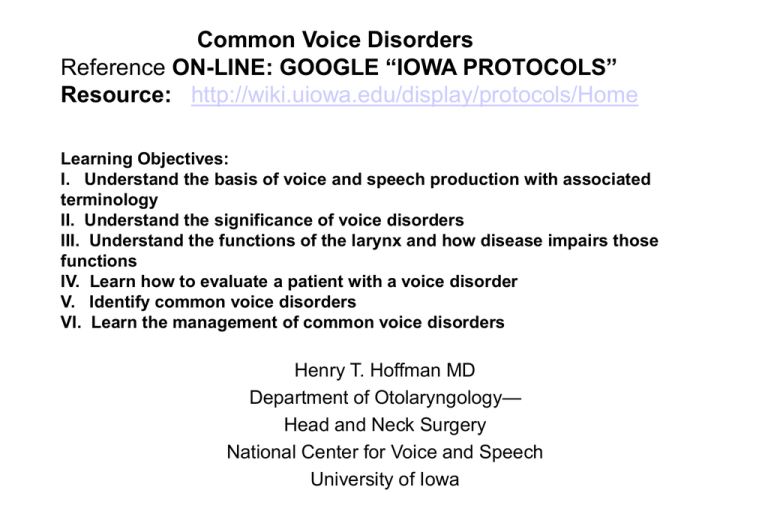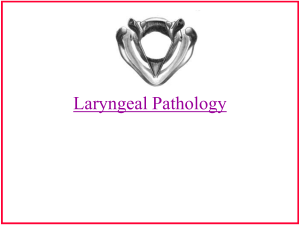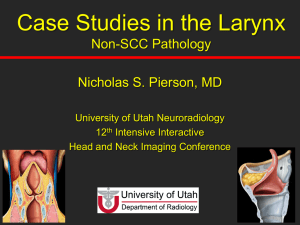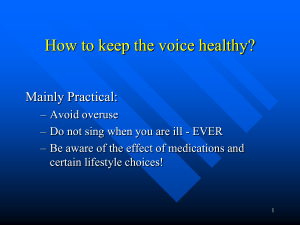Common Voice Disorders
advertisement

Common Voice Disorders Reference ON-LINE: GOOGLE “IOWA PROTOCOLS” Resource: http://wiki.uiowa.edu/display/protocols/Home Learning Objectives: I. Understand the basis of voice and speech production with associated terminology II. Understand the significance of voice disorders III. Understand the functions of the larynx and how disease impairs those functions IV. Learn how to evaluate a patient with a voice disorder V. Identify common voice disorders VI. Learn the management of common voice disorders Henry T. Hoffman MD Department of Otolaryngology— Head and Neck Surgery National Center for Voice and Speech University of Iowa Case Example – Audio then Visual What is your diagnosis? Link to video I. Basis of Voice and Speech Production – Anatomy/Physiology/Terminology A. Glottis = vocal cord area B. Supraglottis= area of larynx above vocal cords (false vocal cords/ arytenoids/epiglottis) C. Subglottis = area of larynx immediately below the vocal cords Coronal section D. I. Basis of Voice and Speech Production – Anatomy/Physiology/Terminology Cough Voice = output from the lung and larynx video of normal videostrob E. Speech = communication resulting from modification of voice by the articulators (tongue/lips/palate/teeth) video of dysarthria F. The function of normal vocal cords Voicing: (a competent glottic valve) ‘Glottic valve’ converts the convert DCDC current of air streaming AC upward from the lung into an AC current. I. Basis of Voice and Speech Production – Anatomy/Physiology/Terminology G. The most superficial layer of the vocal cord is fluid. It overlies the mucosal surface of the vocal cord which also contains muscle and ligament. Normal voicing requires this fluid layer to be present – underscoring key components to the treatment of voice disorders: humidification and hydration. Normal larynx Vocal Folds - Complex Nature Body - Underlying muscle + vocal ligament Cover - Loosely attached epithelium Overlying fluid I. Basis of Voice and Speech Production – Anatomy/Physiology/Terminology G. The combination of adequate breath support (lungs) and app [VIDEO of patient with asthenic voice] I. Basis of Voice and Speech Production – Anatomy/Physiology/Terminology H. Impaired function of the glottic valve results in an abnormal voice and can also impair swallowing and breathing. [VIDEO of bilateral vocal cord paralysis] I. Basis of Voice and Speech Production – Anatomy/Physiology/Terminology I. Passive vibration of the vocal cords rather than active movement by muscle contraction results in voice – this concept explains how a patient with bilateral vocal cord paralysis may have a normal voice. [VIDEO of bilateral vocal cord paralysis #2] I. Basis of Voice and Speech Production – Anatomy/Physiology/Terminology J. Phonation can also occur without vocal cords. A man treated with removal (partial laryngectomy) of cancerous vocal cords is able to produce a lung powered sound (voice) by vibration of the arytenoid mucosa against the base of the tongue. [VIDEO of patient below] 10 year follow-up (video) of patient after supracricoid laryngectomy Lung powered sound: Voice without vocal cords Inspiration (glottis open) Phonation arytenoids against base of tongue I. Basis of Voice and Speech Production – Anatomy/Physiology/Terminology K. More definitions: Voice Disorders - Terminology • Dysphonia = Hoarseness Impaired laryngeal function Impaired lung function • Characterize GRBAS G= overall grade B -“Breathy” - poor glottic closure R -“Rough” - irregularity of vocal fold A - “Asthenic” = weak - poor breath support S - “Strained” - tight glottic closure II. The Significance of Voice Disorders A. Dysphonia as a tipoff to another illness Voice Disorders: Significance Associated Disease • Rough voice • Laryngeal cancer • Recurrent respiratory papillomatosis (RRP) • Breathy voice- laryngeal paralysis • Thyroid cancer • Lung cancer • Asthenia -weak voice • Parkinson’s disease, ALS, Myasthenia gravis • Poor breath support – pulmonary disease • Strain • Anxiety, stress, underlying psychiatric problem II. The Significance of Voice Disorders B. Voice Professional = singers, doctors, lawyers, teachers, anyone using their voice to work Voice Disorders - Significance • Loss of Function • 50% of teachers – vocal impairment • 20% of teachers – loss of work due to dysphonia • >1/3 the work force = ‘voice professionals’ III. Understand the functions of the larynx and how disease impairs those functions A. Impaired function of the glottic valve results in an abnormal voice and can also impair swallowing and breathing. Voice Disorders – Laryngeal Function Airway: Breathing most important Airway protection: Safe swallowing next most important Voice: Least important III. Understand the functions of the larynx and how disease impairs those functions B. Impaired vocal cord/fold vibration results in dysphonia. Common Voice Disorders Impaired vocal fold vibration due to • Vocal fold irregularities Laryngitis infection/trauma/exposure to irritants Nodules/Polyps/Cysts/ scar Tumor papilloma/cancer • Abnormal movement • Paralysis • Muscle tension • Dystonia – Action-induced muscle contraction abnormality – Spasmodic dysphonia = laryngeal dystonia » Ddx includes vocal tremor/muscle tension dysphonia/ » compensation for incomplete glottic closure III. Understand the functions of the larynx and how disease impairs those functions C. Example of dysphonia due to abnormal vocal cord vibration a. Infection: viral/bacterial/fungal b. Trauma: vocal overuse/intubation c. Exposure to irritants: smoke/GE reflux/inhalants Viral Laryngitis • 41 yo female • 7 days of • Rhinorrhea • Hoarseness – Rough – Breathy IV. How to Evaluate a Patient with a Voice Disorder A. Obtain a History Voice Disorders - Evaluation History - PPQRSTA Provokes the hoarseness Palliates the hoarseness Quality of the hoarseness Radiation of the pain (not applicable to voice) Severity sufficient to impair work Timing after a full day of talking Associated symptoms pain,swallowing, breathing IV. How to Evaluate a Patient with a Voice Disorder B. Perform a physical examination Voice Disorders - Evaluation Physical Exam Listen to the voice and breathing Palpate the neck Examine the vocal cords Indirect mirror exam Flexible fiberoptic (transnasal) Rigid videostroboscopic exam Direct laryngoscopy (in operating room) IV. How to Evaluate a Patient with a Voice Disorder C. Methods to image the larynx include: Voice Disorders - Evaluation Physical Exam Examine the vocal cords Indirect mirror exam Flexible fiberoptic (transnasal) Rigid videostroboscopic exam) Direct laryngoscopy (in O.R) IV. How to Evaluate a Patient with a Voice Disorder C. Methods to image the larynx include: flexible fiberoptic transnasal exam of the larynx, [VIDEOS of exam] V. Identify Common Voice Disorders A. Important voice disorders include infectious, neurogenic, traumatic, psychogenic, and neoplastic causes Viral ALS Scarring Trauma: nodule/polyp Psychogenic Neoplastic V. Identify Common Voice Disorders A. Important voice disorders include infectious, neurogenic, traumatic, psychogenic, and neoplastic causes Chronic hoarseness (> 2 weeks or ? >3 months) Neoplastic Glottic cancer: Harsh, breathy voice Supraglottic cancer: “Silent”; muffled voice, neck mass, airway obstruction Subglottic: Airway obstruction RRP (Recurrent respiratory papillomatosis) V. Identify Common Voice Disorders A. Important voice disorders include infectious, neurogenic, traumatic, psychogenic, and neoplastic causes Chronic hoarseness (> 2 weeks or ? >3 months) Psychogenic “Functional aphonia” “Psychogenic aphonia” Muscle tension dysphonia VI. Management of common voice disorders A. Voice disorders may be managed by physicians who are not capable of examining the vocal cords when the presumptive diagnosis is laryngitis through a. voice rest b. humidification c. hydration d. management of associated symptoms (such as cough) and reflux. Laryngitis Laryngitis General Treatment Voice Rest “arms length rule” Humidification Bedside vaporizer Hydration “urine pale” Specific Tx - Infectious Nasal decongestant Anti-tussive Steroids Antibiotics VI. Management of common voice disorders B. Referral to an Otolaryngologist is indicated when a. there is clinical suspicion that the voice disorder is not a self-limited laryngitis b. the voice problem persists longer than two to three weeks; c. there are associated symptoms such as swallowing or breathing impairment VI. Management of common voice disorders C. Medications with adverse effects on the voice include: Drying effect (antihistamines, diuretics, tricyclic antidepressants) Laryngeal irritants (inhaled propellants Factors increasing bleeding risk (aspirin, anticoagulants) Medications in Common Use Affecting Voice (Attenuated List) Adverse Effect Dessication of Vocal Cords - Antihistamines; Diurectics; Tricyclic antidepressants; Other (many) Alter Cord Substance -Birth control pills (controversial); Androgens Inflammation of Cord Surface -Propellants in inhalants Candida Laryngitis - Steroid inhalants Induce Intracordal Hemorrhage -Aspirin; Anticoagulants VI. Management of common voice disorders D. Medications with favorable effects on the voice: Antitussives: codeine/dextromethorphan/benzonatate (Tessalon perles) Mucolytics: guaifenesin Water: H20 (humidification and hydration) Anti-reflux medications (H2 blockers e.g. Zantac /PPI e.g. Prilosec/Omeprazole) Medications in Common Use Affecting Voice (Attenuated List) Positive Effect Mucolytics - Iodinated glycerol; guaifenesin Antitussives - Dextromethorphan, codeine Replacement Therapy - Estrogen (menopause) controversial; Thyroxine (hypothyroid states) VI. Management of common voice disorders E. Speech pathologists manage voice disorders by: Assessing vocal behavior Modifying vocal behavior Maximizing vocal potential Reference for "Common Voice Disorders“ ON-LINE: GOOGLE “IOWA PROTOCOLS” Resource: http://wiki.uiowa.edu/display/protocols/Home Voice Protocols Medical Students Reference for "Common Voice Disorders“ ON-LINE: GOOGLE “IOWA PROTOCOLS” Resource: http://wiki.uiowa.edu/display/protocols/Home Case Example – Audio then Visual What is your diagnosis? Link to video









